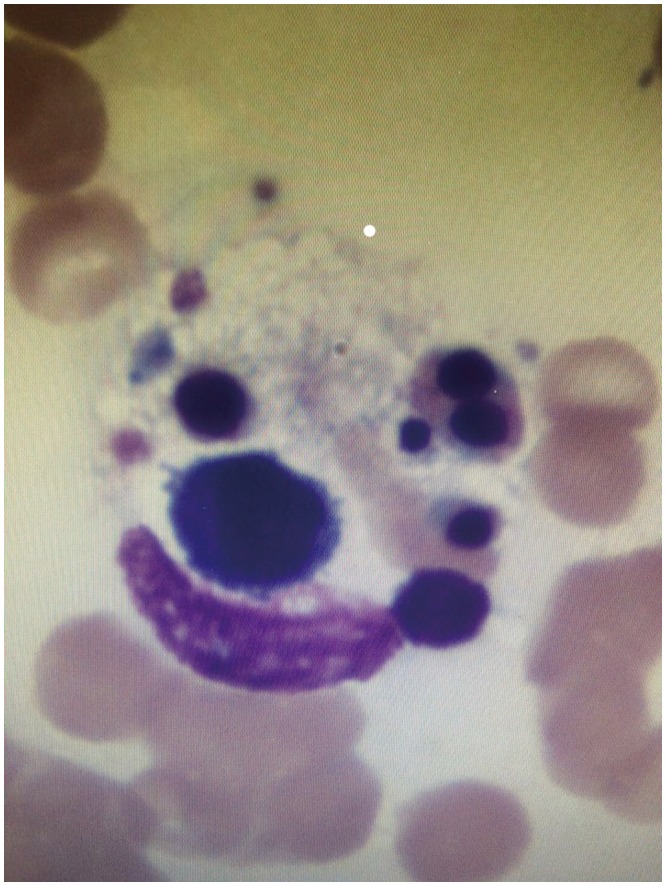Yonsei Med J.
2019 Jun;60(6):592-596. 10.3349/ymj.2019.60.6.592.
Higher Fatality for Severe Fever with Thrombocytopenia Syndrome Complicated by Hemophagocytic Lymphohistiocytosis
- Affiliations
-
- 1Department of Internal Medicine, Yonsei University Wonju College of Medicine, Wonju, Korea. amoxj@yonsei.ac.kr
- 2Department of Laboratory Medicine, Yonsei University Wonju College of Medicine, Wonju, Korea.
- 3Department of Internal Medicine, Yonsei University College of Medicine, Seoul, Korea.
- KMID: 2446966
- DOI: http://doi.org/10.3349/ymj.2019.60.6.592
Abstract
- Severe fever with thrombocytopenia syndrome (SFTS) is an emerging infectious zoonosis caused by the SFTS virus. Hemophagocytic lymphohistiocytosis (HLH) is a life-threatening syndrome associated with excessive immune activation. Cytokine storms are often seen in both SFTS and HLH, resulting in rapid disease progression and poor prognosis. The aim of this study was to identify whether SFTS cases complicated by HLH are related to higher rates of mortality. Descriptive analysis of the frequency of clinical and laboratory data, complications, treatment outcomes, and HLH-2004 criteria was performed. Cases presenting with five or more clinical or laboratory findings corresponding to the HLH-2004 diagnostic criteria were defined as SFTS cases complicated by HLH. Eighteen cases of SFTS were identified during a 2-year study period, with a case-fatality proportion of 22.2% (4 among 18 cases, 95% confidence interval 9%-45.2%). SFTS cases complicated by HLH were identified in 33.3% (6 among 18 cases). A mortality rate of 75% (3 among 4 cases) was recorded among SFTS cases complicated by HLH. Although there were no statistically significant differences in outcomes, fatal cases exhibited more frequent correlation with HLH-2004 criteria than non-fatal cases [3/14 (21.4%) vs. 3/4 (75%), p=0.083]. In conclusion, the present study suggests the possibility that SFTS cases complicated by HLH are at higher risk of poor prognosis.
MeSH Terms
Figure
Reference
-
1. International Committee on Taxonomy of Viruses (ICTV). Taxonomy. accessed on 2017 May 3. Available at: https://talk.ictvonline.org/taxonomy.2. Liu Q, He B, Huang SY, Wei F, Zhu XQ. Severe fever with thrombocytopenia syndrome, an emerging tick-borne zoonosis. Lancet Infect Dis. 2014; 14:763–772. PMID: 24837566.
Article3. Li H, Lu QB, Xing B, Zhang SF, Liu K, Du J, et al. Epidemiological and clinical features of laboratory-diagnosed severe fever with thrombocytopenia syndrome in China, 2011-17: a prospective observational study. Lancet Infect Dis. 2018; 18:1127–1137. PMID: 30054190.
Article4. Kaneko M, Azuma T, Yasukawa M, Shinomiya H. A fatal case of severe fever with thrombocytopenia syndrome complicated by hemophagocytic lymphohistiocytosis. Kansenshogaku zasshi. 2015; 89:592–596. PMID: 26630792.
Article5. Oh HS, Kim M, Lee JO, Kim H, Kim ES, Park KU, et al. Hemophagocytic lymphohistiocytosis associated with SFTS virus infection: a case report with literature review. Medicine (Baltimore). 2016; 95:e4476. PMID: 27495089.6. Kim UJ, Oh TH, Kim B, Kim SE, Kang SJ, Park KH, et al. Hyperferritinemia as a diagnostic marker for severe fever with thrombocytopenia syndrome. Dis Markers. 2017; 2017:6727184. PMID: 28348452.
Article7. Cohen LA, Gutierrez L, Weiss A, Leichtmann-Bardoogo Y, Zhang DL, Crooks DR, et al. Serum ferritin is derived primarily from macrophages through a nonclassical secretory pathway. Blood. 2010; 116:1574–1584. PMID: 20472835.
Article8. Gai ZT, Zhang Y, Liang MF, Jin C, Zhang S, Zhu CB, et al. Clinical progress and risk factors for death in severe fever with thrombocytopenia syndrome patients. J Infect Dis. 2012; 206:1095–1102. PMID: 22850122.
Article9. Nakano A, Ogawa H, Nakanishi Y, Fujita H, Mahara F, Shiogama K, et al. Hemophagocytic lymphohistiocytosis in a fatal case of severe fever with thrombocytopenia syndrome. Intern Med. 2017; 56:1597–1602. PMID: 28626191.
Article10. Kim N, Kim KH, Lee SJ, Park SH, Kim IS, Lee EY, et al. Bone marrow findings in severe fever with thrombocytopenia syndrome: prominent haemophagocytosis and its implication in haemophagocytic lymphohistiocytosis. J Clin Pathol. 2016; 69:537–541. PMID: 26908283.
Article11. Jordan MB, Allen CE, Weitzman S, Filipovich AH, McClain KL. How I treat hemophagocytic lymphohistiocytosis. Blood. 2011; 118:4041–4052. PMID: 21828139.
Article12. Stone NJ, Robinson JG, Lichtenstein AH, Bairey Merz CN, Blum CB, Eckel RH, et al. 2013 ACC/AHA guideline on the treatment of blood cholesterol to reduce atherosclerotic cardiovascular risk in adults: a report of the American College of Cardiology/American Heart Association Task Force on Practice Guidelines. J Am Coll Cardiol. 2014; 63(25 Pt B):2889–2934. PMID: 24239923.13. Levey AS, Eckardt KU, Tsukamoto Y, Levin A, Coresh J, Rossert J, et al. Definition and classification of chronic kidney disease: a position statement from Kidney Disease: Improving Global Outcomes (KDIGO). Kidney Int. 2005; 67:2089–2100. PMID: 15882252.
Article14. Choi SJ, Park SW, Bae IG, Kim SH, Ryu SY, Kim HA, et al. Severe fever with thrombocytopenia syndrome in South Korea, 2013-2015. PLoS Negl Trop Dis. 2016; 10:e0005264. PMID: 28033338.
Article15. Oh WS, Yoo JR, Kwon KT, Kim HI, Lee SJ, Jun JB, et al. Effect of early plasma exchange on survival in patients with severe fever with thrombocytopenia syndrome: a multicenter study. Yonsei Med J. 2017; 58:867–871. PMID: 28541003.
Article
- Full Text Links
- Actions
-
Cited
- CITED
-
- Close
- Share
- Similar articles
-
- Two Cases of Severe Fever with Thrombocytopenia Syndrome Manifested with Hemophagocytic Lymphohistiocytosis Successfully Treated with Steroids
- Severe Fever with Thrombocytopenia Syndrome Accompanied by Hemophagocytic Lymphohistiocytosis
- Severe Fever with Thrombocytopenia Syndrome Patients with Hemophagocytic Lymphohistiocytosis Retrospectively Identified in Korea, 2008–2013
- Severe Fever with Thrombocytopenia Syndrome Presenting with Hemophagocytic Lymphohistiocytosis
- A Case of Hemophagocytic Syndrome Induced by Adenovirus Infection after Splenectomy


